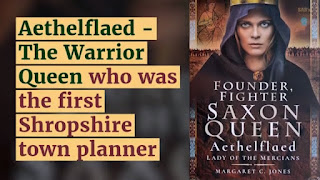The Middle Ages were full of kings, but there are hardly any strong defining women we know much about. There are, of course, notable exceptions such as Elizabeth I, and Hildegard of Bingen.
It now seems that those may be just the tip of the iceberg, and that many more have been recorded in old manuscripts and need to be researched, their stories published and brought out into modern culture.
This article is about one such woman. We are beginning to be told about Aethelflaed, Queen of Mercia, and it seems there may be many more. The rest of this article is devoted to our local female Aethelflaed:
Aethelflaed - The Warrior Queen who was the first Shropshire town planner.
Aethelflaed, the daughter of Alfred the Great, was the first Saxon woman to rule a kingdom.Many of the urban centres we know today, including Shrewsbury, Bridgnorth, Chester and Stafford, are Aethelflaed's gift to the Midlands.
Aethelflaed, Lady of the Mercians, is the subject of a new book by Margaret Jones, who says that in recent years her story has been rediscovered by historians.
Aethelflaed lived over 1,000 years ago, and she was powerful.
She did what no Anglo-Saxon woman before her had done – she led her army in battle, says Margaret in her book, "Founder, Fighter, Saxon Queen," published by Pen & Sword.
Shrewsbury had been founded between 901 and 912, to keep watch from a hilltop over a bend in the River Severn.
St Alkmund's Church, Shrewsbury is unusual in having retained the name and dedication of the original Aethelflaedan church.
This is where Aethelflaed is said to have brought the remains of St Alkmund – Ealhmund – from Derby, to keep them safe from the Danes and to bless the newly established town.
Margaret says while locals in Bridgnorth insist on dating the town from 1101 when a Norman lord built a castle there, but it is almost certainly the place referred to in the Anglo Saxon Chronicles, where Aethelflaed built a burh – a fortified settlement – on a hill overlooking the river in 912.
In 896 the marauding Danes had wintered near Bridgnorth, but were to find it impossible to do so again.
Both Shrewsbury and Bridgnorth were entirely new towns built from scratch, she says, although Bridgnorth was in effect re-founded in the 12th century when the layout of the main streets probably changed.
As a warrior queen defending her realm against invasion, and as the founder of strategic towns like Runcorn, Stafford, Shrewsbury and Warwick, she brought peace to the Midlands and paved the way for the unification of England.
Click the link below to read the book:
https://amzn.to/2CgljrF
Law and Order Before Police Forces
Throughout all-time, and until the end of the medieval period it was believed that the only way to keep order was to make sure that the people were scared of the punishments given for crimes committed.For this reason all crimes from stealing to murder had harsh punishments. Although there were goals, they were generally used to hold a prisoner awaiting trial rather than as a means of punishment. Fines, shaming (being placed in stocks), mutilation (cutting off a part of the body) or death were the most common forms of punishment. There was no police force in the medieval period so law-enforcement was in the hands of the community.
